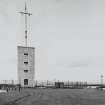Irvine Harbour, Pilot House, Tide Gauge And Automatic Tide Signal
Observation Post (Second World War), Pilot Office (20th Century), Signalling Structure (20th Century), Tide Gauge (20th Century)
Site Name Irvine Harbour, Pilot House, Tide Gauge And Automatic Tide Signal
Classification Observation Post (Second World War), Pilot Office (20th Century), Signalling Structure (20th Century), Tide Gauge (20th Century)
Alternative Name(s) River Irvine; River Garnock; Mine Watching Post
Canmore ID 181690
Site Number NS33NW 40.02
NGR NS 30387 37971
NGR Description NS 30387 37971 and NS 30369 37993
Datum OSGB36 - NGR
Permalink http://canmore.org.uk/site/181690
- Council North Ayrshire
- Parish Dundonald (Cunninghame)
- Former Region Strathclyde
- Former District Cunninghame
- Former County Ayrshire
NS33NW 40.02 30387 37971 and 30369 37993
Pilot House [NAT] (at NS 30386 37970)
Tide Gauge [NAT] (at NS 30369 37993)
OS 1:1250 map, 1956.
4-storey, square tower, monitoring station. Rubble stone, rendered and lined as ashlar, wallhead cornice. Principal elevation (west): window to each floor off-set to left, lamp openings with flat hoods to centre 4 cast-iron grilles to right. 4, 6 and 18-pane windows, roofless design, mast and rigging rising from centre of tower, cast-iron hoppers and downpipes at ground floor to E.
Built to house 'Boyd's Automatic System' for indicating the depth of water at the bar, patented by the Harbour Master, Martin Boyd, in 1904. (Historic Scotland)
Publication Account (1995)
Account of Harbourmaster Martin Boyd's 1903 patent: The Automatic Tide Marker Station
Publication Account (17 January 2017)
This probably unique automatic tide marker station (called the 'Automatic Tide Signalling Apparatus') was housed in the 50 foot tower known as the Pilot House (built 1906) at Irvine Harbour, North Ayrshire. This system functioned as a navigation aid during night and daylight hours by automating light (powered by town supply gas) and colour signals (using coloured balls) as a way of indicating water depth to vessels entering the harbour. The concepts of lights, towers and semiphore style apparatus for distance signalling had been in universal use for many years. This example combined and automated them. The apparatus was designed and patented by Martin Boyd, Irvine Harbourmaster in 1903. Boyd was given £60.00 by the Harbour Authorities to cover the build of the apparatus.
Irvine Harbour is tidal and near the conference of the River Garnock and River Irvine. As a result, silting had always been an issue for harbour operation. The Automatic Tide Signalling Apparatus was designed to indicate the rise or fall of water level at the harbour to the captains of vessels by means of a float connected by wires to the automated tide marker station apparatus (a code of light signals by night and coloured balls by day).
The equipment consisted of a floating chamber or tide gauge (NS30369 37993) of timber calibrated to represent the tide depth at the harbour bar. The bar and the chamber were some distance apart. A wooden float (inside the chamber) rose and fell with the tide. A cable was attached to the float (running through a wooden duct to the Pilot House). The cable was attached to the two devices which occluded (blocked out) the gas light, known as eclipsers (metal frames on wheels running on rails on the outside of the building), which rose and fell with the tide. This gas light was switched off as the eclipser rose. The tide depth at night was indicated by the use of lights which diminished in number as the tide went in or out. In daylight hours a code of black balls was employed (connected to the occluders or eclipsers by rope) which ran on a system of pulleys attached to a staff and cross arm at the top of the tower. This allowed the balls to rise and fall with the tide.
The Pilot House apparatus was updated/refitted but fell into disuse in the 1970s and deteriorated thereafter. The apparatus began to decay and has mostly disappeared. The building was neglected, despite attempts to find other uses.
By 2013, plans were underway to explore options for the future of the Pilot House for the benefit of the people of Irvine and visitors.
Scottish Maritime Museum, 2013.
Note (21 September 2022)
A brick built mine watchers post lies immediately to the N of the tower within the enclosure and is visible on Google Street View (accessed 21 September 2022.
Information from HES 21 September 2022










